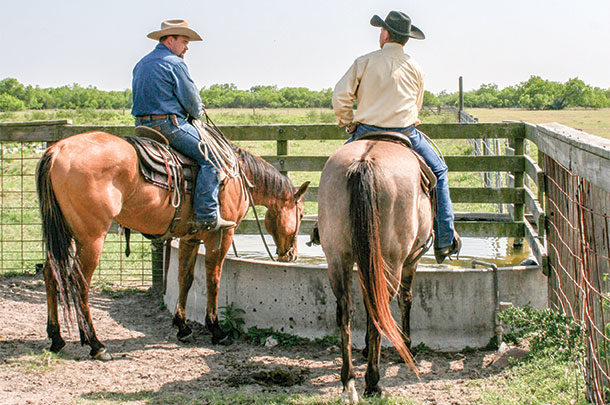They had sweat so copiously their backs were white with evaporated salts, with a few dark spots where they were still sweating, or a fly had managed to pierce the crust and helped itself to a hot, juicy meal. Every morning of each summer, we were out there with those horses, loving our work but sometimes choking on dust (or grasshoppers) as we soaked the backs of our shirts.
Hot weather can take all the nice words out of our mouths when our horse runs out of gas as we hold some sick, ornery mama cow that needs doctoring. That’s enough to make anyone sweat like a Saturday sinner in a hot church on Sunday.
Besides sunscreen and some cool shades for us, what can we do to keep horses performing at their professional best?
Lowdown on electrolytes
Everyone gets sweaty on a hot day, horses and humans alike. But horses perspire more than humans. Besides having a bigger body, their skin contains more than twice as many sweat glands as human skin. Additionally, while humans sweat out more water than electrolytes, horses sweat out more electrolytes per water droplet. Electrolytes are the minerals that all our bodies need for electrical transmission – that is, nerve and muscle function. If you could shrink a horse down to human size, he’d still sweat more and lose more electrolytes than you would doing the same work in the same weather.
Good horse stewards are going to see that their mount has gotten a good drink before he’s loaded in the trailer and at least every couple of hours on the job. You can find all kinds of good information online about administering electrolytes to your horse. The key bit of advice is to give them to your horse before he needs it. Basically, we give a dose before work and thereafter every two to four hours during hot weather. We always give that horse an opportunity to drink after he gets electrolytes, knowing that as he gets thirstier and more tired, it may take longer for him to get that drink.
Experience may show your particular horse does better on a smaller dose sooner, maybe even the day before, rather than the first big salty bolus gulped into a dry gullet after he’s been working half the day. A product called Horse Quencher added to a bucket of water is not cheap but is very good at getting horses to drink. Some budget-minded horses will drink anywhere, any time. That’s a fine trait in a working animal.
Signs that your silent partner is sweltering
One quick way to tell if your horse has got enough coolant in his system is the pinch test. Pinch an inch of skin on the side of his neck. If it vanishes, no worries. If it stays “tented” in a ridge for a second or more, he’s dehydrated and on his way to overheating.
Other tests giving a more complete picture of heat stress are capillary refill time, gum color and heart rate. To check capillary refill time, press your thumb onto the horse’s gums for a few seconds, firmly enough to blanch the color underneath your thumb. Then lift your thumb off and count the seconds it takes for them to return to a healthy-looking light pink color. Any time longer than two seconds indicates dehydration but, for practical purposes, if the gums take longer than a second to return to pink, Ol’ Paint needs a drink.
Naturally, any savvy cowhand is going to notice that if those gums are pale pink, white, grayish or dark pink all the way to brick red, that horse is in shock or suffering a metabolic disorder and needs serious attention. To check heart rate, run your fingers from the back of the horse’s jaw down the jugular groove in his neck until you can feel a pulse. Don’t use your thumb; it has its own pulse that can feel confusing.
Other good spots are on the ribcage just behind and just below the point of the elbow, and just inside the jawbone where you can feel the facial artery cross over to the outside of his face at the front of the chubby round cheek muscle. It’ll feel as big as a pencil lead – except that it pulses, like most pencils don’t.
Heart rates can reach up to around 180 during strenuous exercise, but you’ll want your horse’s pulse to get back down to 60 beats or less per minute after half-an-hour of rest. That’s 10 beats in 10 seconds because a lot of horses won’t stand still long enough to count for a full minute. If, after half-an-hour of rest, the pulse is 80 or more, start looking for a reason and a vet.
At day’s end
One way to cool your horse down in a hurry is to hose him off. Start with the legs and neck, moving to the chest and back. Cold-hosing large, meaty parts of the horse first can actually slow down heat loss, as capillaries in these areas constrict and shunt blood away from the skin. Only hose a horse in the face if he’s used to that sort of thing and not upset by it.
Finally, if the day’s efforts have been extraordinary, keep an eye out for additional health problems, including colic, as a result. These maladies can manifest themselves up to two weeks after a strenuous event.
This summer, keep your cool by keeping your horse cool too. Keeping your mouth shut too might keep those grasshoppers out. ![]()
PHOTO: Good riders will make sure their horses have a good drink every couple of hours while on the job. Staff photo.

-
Louise Loeffler
- Equestrian Specialist and Instructor
- Twin Falls, Idaho









